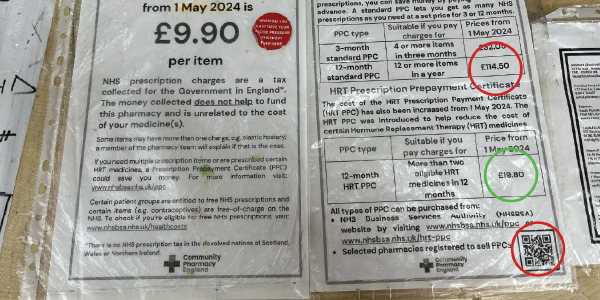This is a tale about the limits of seeing health as services that need to be designed. My tl;dr is that you’re probably not designing a service, you’re probably trying to tweak interactions (or touch points in service design language) in the hope that the service user (barf) has the outcome they expect.
So for the long boring version.
I have experienced perimenopausal symptoms (mostly poor sleep/hot flashes) since 2021 but was ‘too young’ and told to jog on when I requested access to HRT. Years of unsuccessful self-management later, I find myself in front of a male GP last February who says ‘sure, have the combined HRT patch’ after looking up a flow diagram on his computer. I get no more information on what this is beyond ‘make sure you wear it below the waist’. I get an SMS with a link to the NHS page after my visit. Nowhere on this page does it say that there are two kinds of patches and I need to start at the start of my menstrual cycle and switch types after 2 weeks. Nowhere. So I get home, glance at the very long instructions in the box and start to apply the patches, not noticing they have a slightly different packaging design depending on whether they are oestrogen (first 2 weeks of your cycle) or progesterone (last two weeks). So I take the same type of patch for almost 4 weeks and after many backs and forth with the group practice’s prescription team, have to go back to the GP as I have run out of oestrogen patches. With my design hat on, the NHS page could do with some content design but the GP really should have given me clearer instructions. Essentially it was up to me to read Evorel Sequi’s 16 page information leaflet all the way through. Does this count as privatisation of the medical experience? Well if it quacks like a duck.
Fast forward to my second visit to my group practice and the GP is an older woman. She’s really empathetic and prescribes me 12 months of HRT and a cream for my rosacea. I’m back at my local pharmacy who are sadly more used to dispensing methadone than HRT. The pharmacist asks me ‘do you have an exemption?’ and I don’t even know how to answer the question. She goes on to explain that HRT is partly covered by a prepayment certificate and points to her counter where two A4 pieces of paper are taped. I scan the QR code at the bottom of the page but don’t notice I sign up for a certificate for all medication which is £114.50 yearly instead of the HRT specific plan which is £19.80 yearly. I only notice my mistake later but no refund is available. Did I mention I’m not sleeping well?

So what could you do here as a designer? Well again, it comes back to the GP and the first point of contact. I could have done with her mentioning the HRT certificate or getting an SMS about it for eg. And sure you could make a cool poster for the pharmacy but that’s just kicking the can down the road. It’s dealing with a touchpoint where the transaction starts from scratch again. The pharmacy doesn’t know you and doesn’t want to know you. Could the group practice receptionist help? Sure, but that would require her to be considered an actor in someone’s experience of healthcare and everything about how we’re pushed to the NHS app and away from making a telephone call points to the slow disappearance of such roles. The future of healthcare will look more like ordering from McDonalds than walking into a restaurant: transactional, stripped of all personal touches and commercially driven.
To end on a more positive note, I think there’s something about admitting that the service you plan for as a designer is full of unplanned interactions, ad-hoc knowledge exchange and happenstance. Knowing this helps you build in some natural resilience into a service and moments where a situation can go from bad to good. I have the overworked male GP to thank for believing I was ready for HRT and the overworked pharmacist to thank for noticing I could pay less for it. I’ll take the wins where I can get them.
